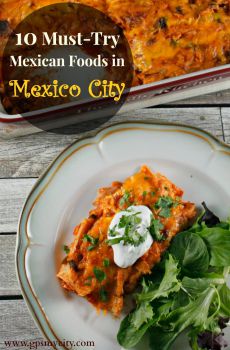
10 Must-Try Mexican Foods in Mexico City
While Mexico is a treasure trove in terms of cultural and artistic heritage (ancient history, architecture, etc.), the vast majority of visitors to the country are lured mainly by, let's face it, bodily pleasures. The latter are manifested in the form of sandy beaches, sun and, most importantly, Mexican food. Indeed, trying authentic Mexican fare in the country of origin is an experience in its own right. As one of the 4 major cuisines (alongside French, Italian, and Chinese), Mexican food has made quite a splash in recent decades around the globe. Listed here are the top 10 considerations not to be ignored by a genuine foodie trying to find his way in Mexico City.
(To visit the venues mentioned in this article, check out these Self-Guided Walking Tours in Mexico City)
1. Enchiladas
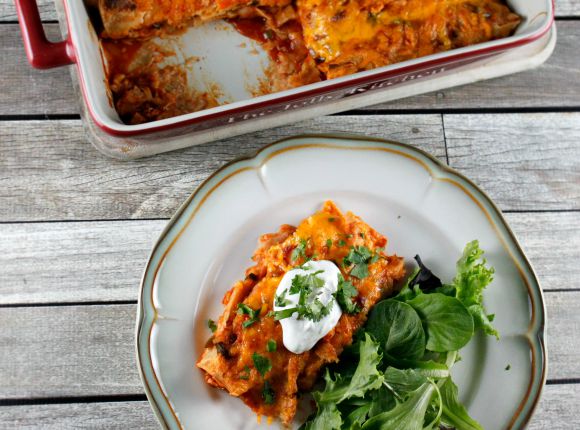
Image Courtesy of: Piera Jolly
Personal Creations
Enchilada is a Mexican starter, much loved by the locals and tourists alike for its taste, relative simplicity, rich flavor and heartiness. There are many different recipes for Enchiladas known to man, involving various meats, vegetables and sauces to go with. There are also purely vegetarian Enchiladas, those with cheese, and so on.
The most popular - Enchilada Suisas - features half-fried corn tortillas stuffed with chicken and poured over with cheese, sauce, cream and topped up with onion slices; just to make sure one doesn't get starved whilst still in bed.
Enchiladas are said to be Mayan invention, dating back to the times when people would rely mostly on corn tortillas with a small fish inside. Nowadays, the stuffing has become more profuse and includes meat, cheese, seafood, beans, vegetables or all that put together. A close ally of Enchilada - chili sauce; together they make an ideal breakfast combination. Enchiladas can go independently, as strong appetizers, or accompany a more substantial meal.
The most popular - Enchilada Suisas - features half-fried corn tortillas stuffed with chicken and poured over with cheese, sauce, cream and topped up with onion slices; just to make sure one doesn't get starved whilst still in bed.
Enchiladas are said to be Mayan invention, dating back to the times when people would rely mostly on corn tortillas with a small fish inside. Nowadays, the stuffing has become more profuse and includes meat, cheese, seafood, beans, vegetables or all that put together. A close ally of Enchilada - chili sauce; together they make an ideal breakfast combination. Enchiladas can go independently, as strong appetizers, or accompany a more substantial meal.
2. Tamales
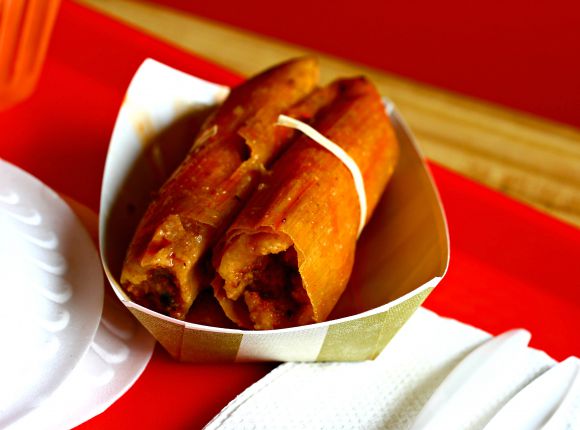
Image Courtesy of: Luke
A tamale or tamal is a Mexican snack that has gained wide popularity across Latin America. It is made of masa (a starchy dough, usually corn-based), steamed or boiled, and wrapped up in a leaf. There are numerous varieties of tamale available. Traditionally, they are wrapped either in corn husks or banana leaves, depending on what grows nearby. In the tropical areas, like Veracruz, they opt for banana leaves, whereas central, southern, and northern parts of Mexico show preference to corn husks. The sight of a street vendor on a bike loaded with a massive pot of tamales, shouting “Tamales Oaxaceños,” is rather commonplace in Mexico City. Depending on the mood, one can choose from a selection of meaty, spicy, or even sweet tamales. Pineapples, green salsa with chicken, chorizo (sausage), are just some of the possible combinations. No tamale bought on the street should be taken without “atole,” a thick drink with a hot chocolate flavor made from watery cornstarch, a by-product of tamale-making process. Nothing should go to waste!
3. Chilaquiles

Image Courtesy of: Joy
Chilaquiles are a typical Mexican breakfast fare that, for some reason, has made quite a splash in neighboring Honduras. The name "chilaquiles" stems from the Nahuatl word "chil-a-quilitl" which translates as "herbs or greens in chile broth". It features slightly fried corn tortillas chopped up in four and poured over with green or red salsa (red is hotter). The centerpiece of the dish is usually scrambled or fried eggs topped up with pulled chicken, cheese and cream. Accompanying Chilaquiles is a healthy dollop of frijoles (fried beans). The original Mexican Chilaquiles beat any foreign tex-mex version hands down. Other than being a strong stomach filler, this dish also happens to be a true redeemer from hangover.
4. Tacos
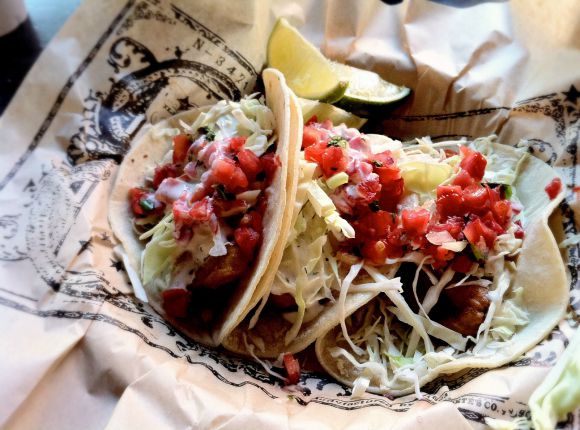
Image Courtesy of: Jing
Taco is a traditional Mexican tortilla made of corn or wheat. They come in small sizes, soft to be flattened and loaded with filling of one's choice - beef, chicken, seafood, vegetables and cheese; the variety of combinations could vary substantially. If you think you know Mexican taco, be sure to first try one from a Mexican street vendor. Folded or rolled, it is usually eaten with hands, accompanied with a side garnish, which could be salsa, avocado or guacamole, cilantro, tomatoes, onions and lettuce, plus a couple of lime wedges to reinforce the impact. Fish tacos are also available, light on the stomach and fabulous on the palate. They may not look spectacular, but taste truly incredible. Besides, it won't set you back more than just a few pesos. Real value for money!
5. Quesadillas
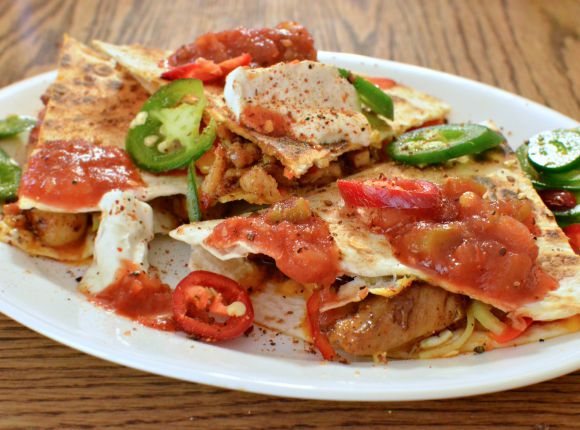
Image Courtesy of: jeffreyw
Quesadilla (pronounced kesaˈðiʎa) is another form of tortilla originated in Mexico, made of flour or corn. To an American eye, though, it would appear more like what they're used to calling "taco". Still, the name quesadilla stems from the Spanish "queso" (cheese) and, therefore, its main filling ingredient is cheese. Together with it comes a vast range of other possible mixes, such as salsa (green or red), chopped onion, guacamole, and sour cream. There could be other ingredients too, e.g. potatoes with chorizo, pumpkin flowers, mushrooms, epazote, huitlacoche, as well as cooked meat (chicken, beef or pork). All of this is meant to be folded in half and served in a crescent-like form. Just as any Mexican tortilla, quesadillas are traditionally made on a comal (frying pan).
6. Pozole

Image Courtesy of: Thelmadatter
Pozole (translated as "hominy") is a traditional Mexican soup or stew which predates the arrival of Columbus. In essence, this is a corn porridge with meat - chicken or pork - or vegetables. Pazole takes hours to cook and is usually left simmering overnight to ensure that hominy gets sufficiently soft and the meat lends its flavor to the broth. The variety of herbs and spices put inside determines different flavors, colors and hotness of pozole – white, green, or red levels. On top of it usually comes a dollop of lettuce, radish, onion, lime, oregano and chili. Thus, it is important to leave the bowl never filled up to the brim with the stew.
7. Guacamole

Image Courtesy of: Nikodem Nijaki
Despite the undisputed popularity of Guacamole, very few realize that this culinary delight of Mexico is centuries old and was invented by the Aztecs. Over time, Guacamole has become a popular appetizer not only in Mexico, but also in the neighboring countries. A traditional companion (a side dish) to tortillas, this dipping sauce comprises mashed avocados, onions, green tomatoes, lemon juice and chili peppers (and, sometimes, a couple of cloves of garlic as well) making it a perfect match to meat, fish or any other food, largely due to the avocado neutral taste.
8. Burritos

Image Courtesy of: bloomsburys
A burrito (otherwise known as taco de harina) is a Mexican wheat flour-tortilla served with a filling. Burritos originate in the north of Mexico, namely in the city of Ciudad Juárez, the state of Chihuahua, and are said to be a northern variation of traditional taco de Canasta. Translated as “little donkey,” they are relatively less popular in other parts of Mexico. The best ones are reputedly served in the town of Villa Ahumada.
To get them soft and easy to handle, burritos are slightly grilled or steamed. Original burritos come small and thin, and contain just a handful of ingredients: meat or fish, potatoes, rice, beans, asadero cheese, chile rajas, or chile relleno. On top of that might come barbacoa, mole, chopped hot dogs cooked in a tomato and chili sauce, refried beans and cheese, deshebrada (shredded slow-cooked flank steak). The latter may appear in two forms: with chile colorado (mild to moderately hot) and salsa verde (very hot).
Unlike elsewhere in North America, where they put everything inside, in Mexico they put the toppings (salsa, lettuce, cheese, onions) on the side of the dish.
To get them soft and easy to handle, burritos are slightly grilled or steamed. Original burritos come small and thin, and contain just a handful of ingredients: meat or fish, potatoes, rice, beans, asadero cheese, chile rajas, or chile relleno. On top of that might come barbacoa, mole, chopped hot dogs cooked in a tomato and chili sauce, refried beans and cheese, deshebrada (shredded slow-cooked flank steak). The latter may appear in two forms: with chile colorado (mild to moderately hot) and salsa verde (very hot).
Unlike elsewhere in North America, where they put everything inside, in Mexico they put the toppings (salsa, lettuce, cheese, onions) on the side of the dish.
9. Elote

Image Courtesy of: jeffreyw
Elote is what the Mexicans call corn on the cob. This is a popular street snack, although one can frequently find it cooked in households, throughout the country, the traditional way - boiled in husk. Whenever you find yourself starving whilst walking the streets of some Mexican town at the end of the day, be sure to find it alongside many other street-food options on offer.
10. Salsa

Image Courtesy of: Neil Conway
No food is Mexican enough if not smothered with salsa. One cannot get too much of this appetizer made of roasted tomato. There're quite a few salsa options available, including traditional spicy salsa roja (red), salsa verde (green), salsa cruda, salsa negra (black), salsa brava, etc. All of them are truly phenomenal!
Get GPSmyCity App for IOS or Android
You can read offline thousands of travel articles like this one in the "GPSmyCity: Walks in 1K+ Cities" app on Apple App Store or Google Play Store. The apps also offer city offline maps and GPS navigation to guide you to the places featured in the articles.
Walking Tours in Mexico City, Mexico
Create Your Own Walk in Mexico City
Creating your own self-guided walk in Mexico City is easy and fun. Choose the city attractions that you want to see and a walk route map will be created just for you. You can even set your hotel as the start point of the walk.
Historic Center Walking Tour
Mexico City is the oldest capital in the Americas and is one of the two founded by indigenous people. Originally known as Mexico Tenochtitlan, the city was built by the Mexicas (aka Aztecs) in 1325. According to a legend, the Mexicas' principal god, Huitzilopochtli, pointed out the site of the future settlement with an image of a golden eagle perched on a prickly pear cactus, devouring a... view more
Tour Duration: 2 Hour(s)
Travel Distance: 2.7 Km or 1.7 Miles
Tour Duration: 2 Hour(s)
Travel Distance: 2.7 Km or 1.7 Miles
Historic Center Food Tour
A combination of history and tradition in Mexico City permeates all aspects of life, including food. For centuries, food and drink have been an inseparable part of the city's culture. Within Mexico City's bustling historic center, you can find a variety of culinary gems that offer a taste of what we call diverse Mexican cuisine.
One of the must-visit spots here is the San Juan Market.... view more
Tour Duration: 1 Hour(s)
Travel Distance: 1.6 Km or 1 Miles
One of the must-visit spots here is the San Juan Market.... view more
Tour Duration: 1 Hour(s)
Travel Distance: 1.6 Km or 1 Miles
Chapultepec Park Walking Tour
Nicknamed "the Lungs of Mexico City", Chapultepec Park is a vast oasis of lush greenery in the heart of the Mexican capital, sprawling over 686 hectares of land, providing a vital source of oxygen for the city. Rich in natural beauty, historical landmarks, and vibrant atmosphere, throughout centuries, this park has inspired various works of literature, poetry, and visual art, further... view more
Tour Duration: 2 Hour(s)
Travel Distance: 3.8 Km or 2.4 Miles
Tour Duration: 2 Hour(s)
Travel Distance: 3.8 Km or 2.4 Miles

























